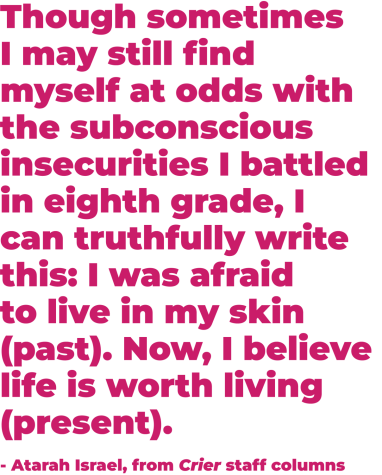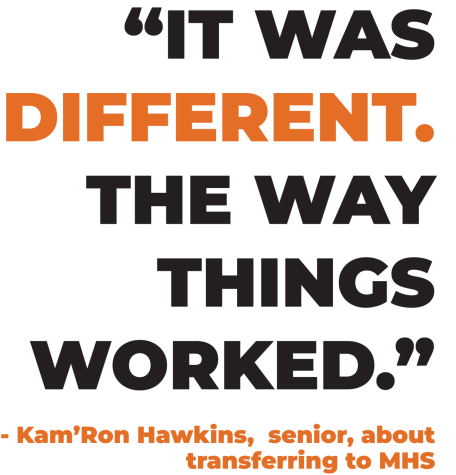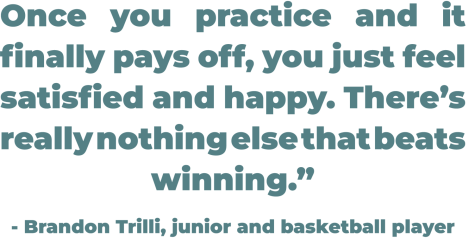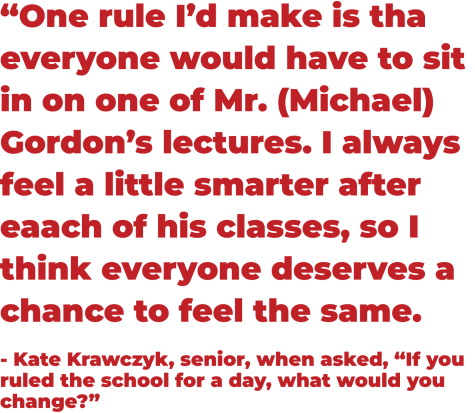THIS IS MUNSTER
How are we different? How are we alike? What makes a MHS student unique? What are the experiences that define us? These are the various questions Crier seeks to answer through your voices.
April 21, 2022

As of this school year, MHS has a student population of a little over 1,600.
This does not include teachers, administrators, guidance counselors, secretaries and faculty that make up the unique identity of MHS. More important than sheer numbers, however, are the ties that bind us together throughout our four years. Continue navigating to read narratives about your experiences as members of the MHS body.

“It may seem impossible to catch every student voice, and it certainly is a daunting task. Instead, it is much easier for us to highlight the growing number of diverse groups (and, therefore, perspectives and voices) in our school. According to the Indiana Department of Education, MHS was comprised of 19.5% economically disadvantaged students, 8.4% disabled students and 1.7% English learners in the 2020-2021 school year.
The IDOE also reports white, Hispanic, Black, Asian and Native American students all being represented at MHS, though the difference between the most represented group (white) and second-most represented group (Hispanic) is over 26%. Social and racial groups comprise only a part of our identity, though. In a Crier survey of 290 students, 54.5% of students participate in a sport, 58.3% are in a performing arts club or class, 64.8% are in an academic club and 67.2% are in a cultural club. Though it sometimes does not feel that way, MHS is becoming a microcosm of society at large, with a growing number of students from various backgrounds. As members of this microcosm, it is our responsibility to learn how to recognize, reconcile and accept the differences among us.”
Click here to read the rest of our editorial about why we created this issue.

 “I have lived in Munster practically my entire life. Sometimes I resented the fact that I have lived in the same place for nearly 15 years. I wanted to run away. But now that I am leaving, I have realized how much Munster has provided me, despite its flaws.
“I have lived in Munster practically my entire life. Sometimes I resented the fact that I have lived in the same place for nearly 15 years. I wanted to run away. But now that I am leaving, I have realized how much Munster has provided me, despite its flaws.
I first began to realize when an adult told me, “You’re lucky to go to Munster. Other families would love to go here.” I laughed uncomfortably, not really understanding. But it made me curious. I met a kid who transfered from a neighboring school. They said, “I’m so happy I get to go here. They teach a lot better here.” I was confused, because I thought all teaching is mostly the same. But it was when I was talking to another girl about my extracurriculars, she said, “I wish we had all those clubs.” Shocked, I asked her why she didn’t have clubs. She shrugged, saying, “No one wants to sponsor them. But also money. Money’s a huge factor.”
Click here to read what Crier staff has to say about life at MHS.

“When I was just a freshman at MHS, I was terrified. The school seemed like a maze no matter where I went. Eventually, though, I got used to it. I was already in a bowling league at the Stardust in Dyer when Casey Knor’s dad, who was a coach, asked if I wanted to join the school bowling team.”
Click here to read Lita Cleary’s junior, column, and more student narratives about the Honors programs and girls in STEM.

“As a freshman, entering this big scary building for the first time, I was desperate to find friends and a place where I belonged. I tried a lot of activities, ranging from Theater to Choir to Spanish Club (and I was really bad at Spanish). What I found through this search was the community of MHS as a whole. We gravitate to people that share our common interests, but taking myself out of my comfort zone helped widen my circle and find a better understanding of myself in the process.”
Click here to read the rest of Robyn Dejoan’s, senior, column, as well as Alyx Salamanca’s experience as an ACC student.
“As a 5’6” 15- year-old, I spent most of my freshman year running around the hallways, bothering upperclassmen (as well as annoying my peers) and studying in the media center during lunch periods. For those of you who know me today, a lot has changed (maybe not the annoying peers part). Aside from more obvious physical changes, my perspectives, values and ideologies have also changed. How did I get here? Well, it took some time, some growing and some rebuilding.”
Click here to read the rest of Charlie Mason’s, senior, column, as well as other student narratives about Munster Theatre Company and volunteering.
“I was born on June 21, 2005. Depending on what website you use, some say I’m a Cancer and others say I’m a Gemini. In fact, I sit on the very edge of the Gemini time period; if I was born just two hours later I would have been a Cancer. This may seem insignificant, but it represents a bigger pattern I’ve noticed in my life: I have always been caught in the middle of identities, and my place in the world has been defined by a give and take system of belonging.
Whether it is as minute as my astrological sign, or as grand as the two contrasting cultures I grew up with, I have always found myself in between social groups. Ever since I moved to the US when I was four, I sensed that I was not quite the same as other kids. I was, and still am, at the crossroads between Pakistani and Western culture. Though I was never fully rejected, I constantly feel as though there is not a space for me. I watched others find comfort in their culture, and wondered why I could not do the same.”
Click here to read more student narratives about club experiences, personal growth and more.

Arriving from the Netherlands in July of 1885, Jacob Monster, along with his father and younger brother, became some of the first settlers of what is now Lake County. He opened up the first general store and U.S. post office on Ridge Road in 1870, and Munster eventually became a town in 1907. Influenced by the townspeople, Jacob changed his surname to “Munster,” giving the town its name.
At the construction cost of $16.00, the first schoolhouse was built in 1852 at Greenwood Ave and Ridge Road. Originally holding lessons at their own home, Chauncy Wilson, and his wife, Julia Ann, taught the first students in Munster. As population grew, Jacob Munster decided to build Munster School on the corner of Calumet Ave and Ridge Road, which would eventually become the town hall, and then demolished in  1920. Teaching continued at what is now The Center for Visual Performing Arts until Elliott and Eads Elementary School were built in 1949 and 1953.
1920. Teaching continued at what is now The Center for Visual Performing Arts until Elliott and Eads Elementary School were built in 1949 and 1953.
Since around 500 Munster residents were attending high school in Hammond or Griffith, the town decided to build Munster High School in 1966. Throughout the 1970s, the school’s classrooms, offices, fieldhouse, science labs and art and music facilities were renovated. This tradition of change continues until this day, with some of the newest improvements this year being the new Fabrication Lab and new paint and flooring on the north side of the school.
Although the school has gone through many physical changes over the years, there has also been changes in demographics. In 2005, 78% of MHS students were white while this school year it is 56.4%. This downward trend reflects the increase in other races being represented at MHS, but it only tells a part of the school’s story with growing diversity. Specifically, transfer students reflect the unique process of adjusting to MHS culture. Whether hailing from South Africa or Hammond, students looking from the outside in often share similar experiences.
Sources: munster.us, munsterhistory.org, findagrave.com
Click here to read about student experiences transferring to MHS.

“I really liked athletics a lot here. It was everything I did. I’ll never forget spirit weeks. Everybody participated and it was almost a competition within your grade who had the best spirit outfit. That was always fun. My senior year was also the year Munster flooded. So it was a week without being here, and it was Homecoming week. That is something that, in a sense, was taken from us but made us stronger, especially as our senior year.”
Click here to read about MHS alumni-turned-teachers, and their experiences as both students and teachers.

Students packed shoulder-to-shoulder in the bleachers. The thundering roar of the crowd bursting with chants and cheers. The thrilling nerves of the uncertainty of the game’s outcome. As he observed his surroundings, Brandon Trilli, junior, felt electrified by the exhilarating atmosphere. The night Boys’ Basketball won Sectionals was undoubtedly imprinted in his memory.
“It was a weird feeling. I understood how big (Sectionals) were, but it wasn’t to this degree in Arizona, so I never realized it was actually a big deal,” Trilli said. “It didn’t really sink in until the game was over that we were Sectional champions. It feels satisfying when you work so hard for something and you’re finally able to compete. Once you practice and it finally pays off, you just feel satisfied and happy. There’s really nothing else that beats winning.”
For Hannah Robbins, senior, running served as an outlet to escape from the day-to-day hardships she faced. As a member of Track, Cross Country and Girls’ Swim, Robbins felt more than disheartened when she tore her labrum last year in March, which led to ongoing complications with a bulging disc in her back. The injury to her labrum barred her from competing for the remainder of the season.
“This is going to sound really dramatic but in my brain, that was like the end of the world for me,” Robbins said. “I thought I’d never be able to do sports ever again. I just used (sports) as an escape, but when that got taken away, I didn’t really know what to do with myself. But, I feel like it grew me as being able to learn hat not everything may go your way. I grew from that as a person and who I am today.”
Click here to read about two MHS athletes, and how they paved their own path in their respective sports.

Click here to read the rest of the Prom court’s backtalk responses.

To read more stories from MHS students, click here.
How has being a student at MHS changed you as a person? What is one thing you would change about MHS?




